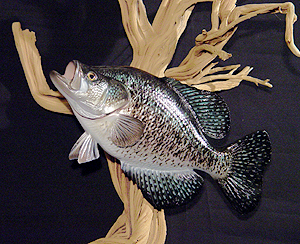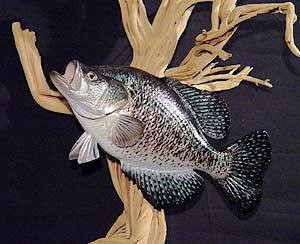Pixels are the best way to look at the dimensions
of a digital photo to relate to it's size in
different presentations. They are expressed as
pixels per inch or PPI. The easiest medium to
relate this to is the computer monitor screen
or display. It's resolution is also measured
in pixels. The most common monitor size today
is a 17", that size refers to the diagonal
dimension of the screen. In the case of a CRT
monitor (one like a TV) it will measure less
because the housing overlaps the edges. With LCD
(Liquid Crystal Diode), which are the flat thin
panel displays, the diagonal will measure the
actual size. Most people use a 17" monitor at a
setting of 1024 X 768. Some prefer to have everything
look bigger and use a lower resolution (800 X 600)
to accomplish this. That's right, I said lower.
This illustrates the relationship of PPI to a
pictures actual size on a monitor screen. To see
what your screen setting is, right click your mouse
on the desktop, select "Properties" and open the
"Settings" tab.
Let's say you have a picture from your camera and
using your photo editing software you determine it
is 1984 X 1488. If you want to display it on your
monitor as a full background image you need to
reduce it in size. If your monitor is set at
1024 pixels wide and 768 pixels high, you would
reduce one dimension of the picture and let the
other stay so it remains at the proper proportion
(this camera's pictures are the same proportion as
the screen). Changing both dimensions without being
proportional would result in a distorted picture.
In this case, changing the width to 1024 will
result in a 1024 X 768 picture and fill the whole
screen when used as a background on this monitor.
If you change it to 800 it will end up as an 800
X 600 size and will only fill that portion of the
screen, unless you have your monitor set to 800 X
600, in which case it will fill the screen
What if you want to send someone the picture in e-mail
or post it on a bulletin board? A picture that will
fill the whole screen is too big! let's look at some
relative sizes on your display:
This line is 200 pixels long:
This line is 400 pixels long:
This line is 600 pixels long:
It should be clear that a picture with a dimension
of 600 pixels is big for posting on a bulletin board.
300 to 400 would be much better. There is also another
consideration when e-mailing, placing on a web site
or posting. That is the file size, which is not the
measure of a picture in pixels. File size is measured
in bytes of required storage. This is usually more
than a thousand and referred to as kilobytes or K.
When viewing pictures on a web site your computer
must transfer and store the picture to it's memory
and possibly store it as a temporary file on your
computer. The larger the file size and the slower
your Internet access speed is, the slower the
process. I'm sure you've all visited web sites
that took a long time to load. Pictures and/or
graphic with too large of file size is usually
the cause. I'm also sure you've experienced problems
in bulletin boards loading because someone has posted
a picture too large in pixel dimensions and/or file size.
Now let's see the process in preparing pictures
for use on the Internet by resizing and compressing
file size. The first step is to resize them to a
manageable size. Between 300 and 400 pixels is small
enough to have a small file size and large enough to
have detail. Look at the lines above to get an idea
of this.
What about PPI? On a monitor display it won't effect
the physical size. The size is determined by the number
of pixels displayed (determined by the resolution
setting) and the relative amount of the pixel dimension.
A 512 pixel wide picture will be half as wide as a
1024 wide screen display and about 64% of an 800
wide screen display.
NOTE: Photo editing software will allow you to "enlarge"
pictures as well as reduce, but I advise NOT doing that.
As you enlarge, you reduce the quality. Only use it to
make them smaller.
As an example to illustrate resizing and compression,
the photo below is resized from a larger picture
(2560) to 300 pixels wide, the photo on the left
has a file size of 119K, the one on the right is
compressed to 16K. They both are 72 PPI and have
the exact same dimensions. Even though the right
picture has a file size that is less than 14% of
the one on the left, it still looks good on your
screen.
 |
 |
This photo is 119K in file size.
load with 56K modem = 22 sec. |
This photo is 16K in file size.
load with 56K modem = 3 sec. |
and are used here with his permission.
This Crappie photo shows that pictures the same
physical size can have very different file sizes.
Comparing the estimated load times illustrates
the benefit to those with slow Internet access
and shows that compression with good software
gives quality results. This particular compression
was done using Adobe Photoshop Elements with a
quality setting of only 35. The original photo,
out of the camera, is 2560 pixels wide and has a
file size of 2.28 MB or 2280K. If this large photo
were posted on a bulletin board it would take at
least 11 minutes to load with a fast modem and
about a 40" monitor to view it all at once.
®
Good photo editing software allows you to compress
with options like "save for web" or just saving as
a jpg type with the ability to choose the amount of
compression and usually a preview and an estimated
"load time" at various modem speeds. With some
experimenting you will see how much you can compress
without losing too much.
When it comes to printing a picture, you must look
at things differently. Printing quality is evident
when comparing a newspaper picture with a magazine.
If you look close you can actually see the dots
that comprise the newsprint and the spaces in between.
The dots can be thought of as pixels. They are so
many in the magazine picture you can't see where
one begins and another ends. The high number of
dots give the picture higher quality. The PPI
required to have a nice looking picture for monitors
is as little as 72 PPI. Printers, however, will be
seriously effected by the PPI. It will be a factor
in the size and quality. A higher PPI will produce
a better quality print. The large Crappie picture
that I talked about would be great for printing.
Realize that you will need more pixels to make
the picture because the desired PPI is a larger
number.
Inches X PPI = total number of pixels
A 4" wide picture at 72 PPI requires the pixel
dimension to be 288.
72 PPI would not produce
a good quality print.
A 4" wide picture at 300 PPI requires the pixel
dimension to be 1200, but would be a better quality
print. It would also have a larger file size
Number of pixels ÷ PPI = size in inches of printed picture.
Keep in mind the importance of small file size for
web use (fast loading) and large file size for
printing (high quality and size), and the same
applies for pictures that are scanned in.
Tip of the Week
Finding what your're looking for on a web site page
can be easy with the "Find" function of youre browser.
It is accessed by pressing the "Ctrl" key and the "F" key
at the same time or in the top menu under "Edit." Simply
type in the word you want to find and click "Find Next"
button or press the "Enter Key" This is for sites that
do NOT use frames. Sites that do use frames (two or
more sections that comprise the whole page), like FAOL,
will require you to select the frame first. For example,
if you go to the "Fly Tying" section and select "Fly Archives,"
you will be at a page with frames. the one on the left
has the names of flies listed. Select this section by
clicking anywhere in an empty spot. Then type in caddis,
press "Enter" or click "Find Next" and you will find
the first caddis pattern. Keep pressing "Enter and you
will keep finding all the caddis patterns on that page.
Note: Sometimes frames are not clearly visible so if
the search isn't working, try click selecting the area
you want to search.
I hope this helps! ~ JM
|



